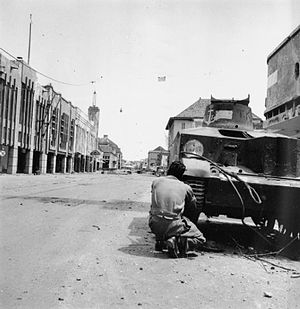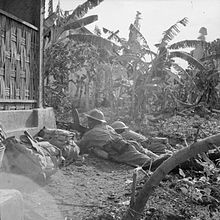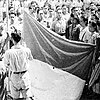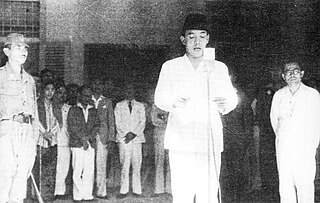
The Indonesian National Revolution also known as the Indonesian War of Independence, was an armed conflict and diplomatic struggle between the Republic of Indonesia and the Dutch Empire and an internal social revolution during postwar and postcolonial Indonesia. It took place between Indonesia's declaration of independence in 1945 and the Netherlands' transfer of sovereignty over the Dutch East Indies to the Republic of the United States of Indonesia at the end of 1949.

Sukarno was an Indonesian statesman, orator, revolutionary, and nationalist who was the first president of Indonesia, serving from 1945 to 1967.

South East Asia Command (SEAC) was the body set up to be in overall charge of Allied operations in the South-East Asian Theatre during the Second World War.
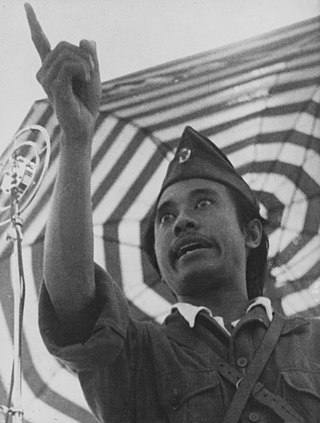
Sutomo, also known as Bung Tomo, was an Indonesian freedom fighter, and is best known for his role as an Indonesian military leader during the Indonesian National Revolution against the United Kingdom and the Netherlands. He played a central role in Battle of Surabaya when the British attacked the city in October and November 1945.

Ambarawa is a town located between the city of Semarang and Salatiga in Central Java, Indonesia. Administratively, it is bordered by the districts of Banyubiru to the south, Jambu to the west, Bandungan to the north, and Bawen to the east.

This is the timeline of Indonesian National Revolution.

The Bandung Sea of Fire refers to the deliberate burning of much of the southern side of the city of Bandung by retreating Indonesian Republican troops during the Indonesian National Revolution.

Idrus was an Indonesian author best known for his realistic short stories and novels. He is known as the representative of the prose of the '45 generation of Indonesian literature.
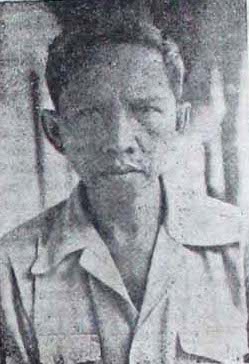
Soekarmadji Maridjan Kartosuwiryo was an Indonesian Islamic mystic who led the Darul Islam rebellion against the Indonesian government from 1949 to 1962, intending to overthrow the secular Pancasila ideology and establish Negara Islam Indonesia based on sharia law.

Bersiap is the name given by the Dutch to a violent and chaotic phase of the Indonesian National Revolution following the end of World War II. The Indonesian word bersiap means 'get ready' or 'be prepared'. The Bersiap period lasted from August 1945 to November 1947. In Indonesia, other terms aside from bersiap are commonly used, such as gedoran in Depok, ngeli in Banten and surrounding West Java, and gegeran and dombreng in Central Java.
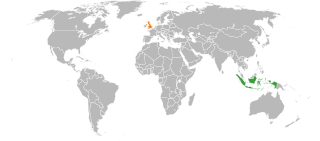
Indonesia and the United Kingdom established diplomatic relations in 1949 and have maintained strong relations since then. Indonesia has an embassy in London while the United Kingdom has an embassy in Jakarta. The United Kingdom considers Indonesia an increasingly important partner globally and is committed to efforts to take bilateral relations to new heights. Both nations are members of G-20 major economies.

Brigadier Aubertin Walter Sothern Mallaby CIE OBE was a British Indian Army officer killed in a shootout during the Battle of Surabaya in what was then the newly proclaimed as independent Republic of Indonesia during the Indonesian National Revolution. At the time of his death, Mallaby was the Commanding Officer (CO) of the 49th Indian Infantry Brigade.

Major General Professor Moestopo was an Indonesian dentist, freedom fighter, and educator. He was declared a National Hero of Indonesia on 10 November 2007.

The East Sumatra revolution, also known as the East Sumatra social revolution, began on 3 March 1946. Across 25 "native states", many sultanates were overthrown and mass killing of members of the aristocratic families were performed by armed pergerakan groups. To the opportunistic pergerakan militants, the revolutionary movement was seen as one of the means for East Sumatra to be freed from colonial overlordship and to join the larger Indonesian National Revolution. Participants of the revolution were believed to be provoked by leaders to kill aristocrats and create violence. These belligerents had three prime objectives: to eliminate the sultans and aristocrats, to seize their wealth and to eliminate the region's feudal social structure. The revolution brought about the formation of the State of East Sumatra, which was dissolved when the region became part of the Indonesian republic.
K'tut Tantri, born Muriel Stuart Walker, was a Scottish American woman who was best known for her work as a radio broadcaster for the Indonesian Republicans during the Indonesian National Revolution. Due to this work, she was referred to by the nickname "Surabaya Sue" among British and Dutch news correspondents.

November 10th is a 2015 anime-influenced Indonesian animated war drama film, produced by MSV Pictures. It is directed by Aryanto Yuniawan and produced by M. Suyanto. It won Most People's Choice Award in the International Movie Trailer Festival (IMTF).
Major General Muhammad Mangundiprojo was a 20th-century Indonesian soldier, revolutionary, and civil servant. Born in Sragen Regency on the island of Java, Mangundiprojo joined a nationalist group during the Second World War. He later fought against the return of Dutch colonial authority to Indonesia, and later went on to become a politician. He died in Bandar Lampung in 1988.
The Kolaka incident, known locally as the 19 November incident, was an ambush of a Dutch military convoy near Kolaka, Southeast Sulawesi on 19 November 1945, during the early months of the Indonesian National Revolution.
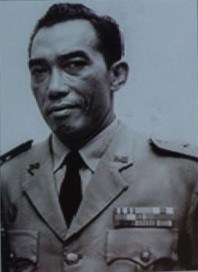
Lieutenant General Djamin Ginting, was an Indonesian military officer and independence fighter from Tanah Karo. He was appointed a National Hero of Indonesia by President Joko Widodo on 7 November 2014.

The Hotel Yamato incident was the tearing of the blue colour of the Dutch flag flying at Hotel Yamato on 19 September 1945, which was preceded by the failure of negotiations between Soedirman and W. V. C. Ploegman to lower the Dutch flag.
